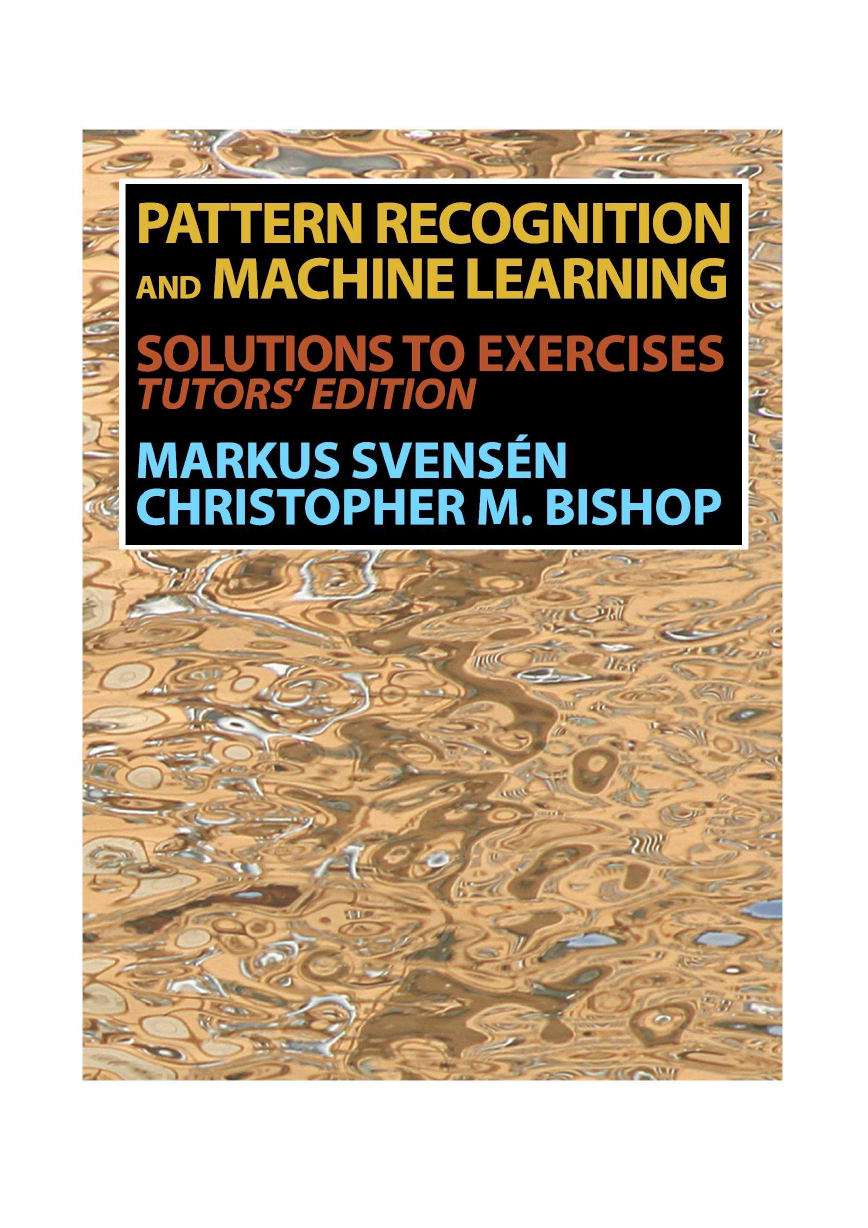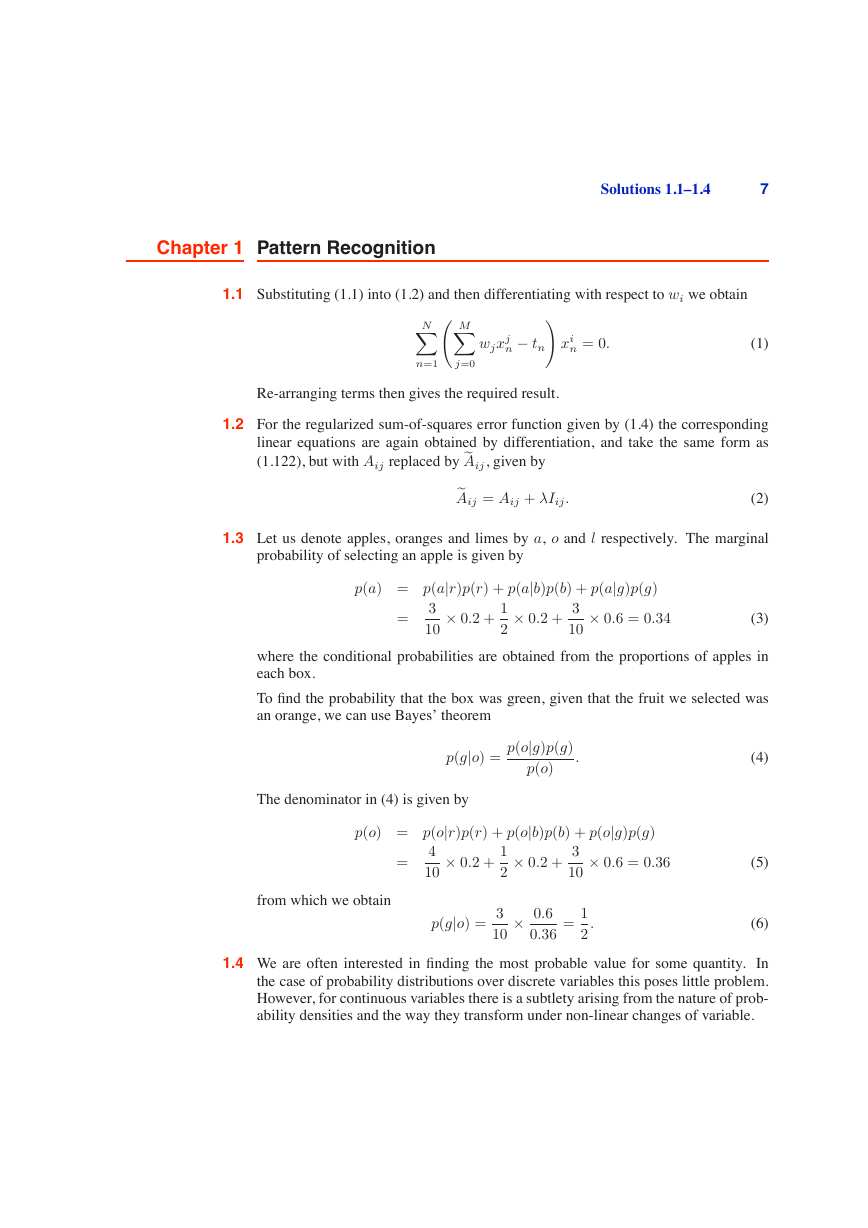�
Pattern Recognition and Machine Learning
Solutions to the Exercises: Tutors’ Edition
Markus Svens´en and Christopher M. Bishop
Copyright c! 2002–2008
This is the solutions manual (Tutors’ Edition) for the book Pattern Recognition and Machine Learning
(PRML; published by Springer in 2006). This release was created March 20, 2008. Any future releases
(e.g. with corrections to errors) will be announced on the PRML web-site (see below) and published via
Springer.
PLEASE DO NOT DISTRIBUTE
Most of the solutions in this manual are intended as a resource for
tutors teaching courses based on PRML and the value of this resource
would be greatly diminished if was to become generally available. All
tutors who want a copy should contact Springer directly.
The authors would like to express their gratitude to the various people who have provided feedback on
pre-releases of this document.
The authors welcome all comments, questions and suggestions about the solutions as well as reports on
(potential) errors in text or formulae in this document; please send any such feedback to
Further information about PRML is available from
prml-fb@microsoft.com
http://research.microsoft.com/∼cmbishop/PRML
�
�
Contents
Contents
. . . . . . .
. . . . . . .
. . . . . .
. . . . . . .
Chapter 1: Pattern Recognition . . . . . . . . . . .
Chapter 2: Density Estimation . .
Chapter 3: Linear Models for Regression . . . . . . . . . . .
Chapter 4: Linear Models for Classification .
Chapter 5: Neural Networks
. . . . .
Chapter 6: Kernel Methods . . . . . .
Chapter 7: Sparse Kernel Machines . .
Chapter 8: Probabilistic Graphical Models . . . . .
Chapter 9: Mixture Models . .
. . . . . . .
Chapter 10: Variational Inference and EM . . . . . .
Chapter 11: Sampling Methods . . . . . . . . .
Chapter 12: Latent Variables
Chapter 13: Sequential Data
Chapter 14: Combining Models . . . . . . . . .
5
7
. . . . . . . . . . . .
28
. . . . . . . .
62
. . . . . . .
78
.
. . . . . . . . . . . .
93
. . . . . . . . . . . . 114
. . . . . . . . . . . . . . 128
. 136
. . . . . . . . . . . 149
. . . . . . . . . . . 163
. . . . . . 198
. . . . . . . . . . . . 207
. . . . . . . . . . . 223
. . . . . . 246
. . . . . . .
. . . . . . .
. . . . .
. . . . .
.
. . . . .
. . . . . . . .
. .
. . . . . .
. . .
. . . . .
. . . . . . .
. . . . . . .
. . . . . . . .
5
�
6
CONTENTS
�
Solutions 1.1–1.4
7
Chapter 1 Pattern Recognition
1.1 Substituting (1.1) into (1.2) and then differentiating with respect to wi we obtain
N!n=1" M!j=0
n − tn# xi
wjxj
n = 0.
(1)
Re-arranging terms then gives the required result.
1.2 For the regularized sum-of-squares error function given by (1.4) the corresponding
linear equations are again obtained by differentiation, and take the same form as
(1.122), but with Aij replaced by$Aij, given by
$Aij = Aij + λIij.
1.3 Let us denote apples, oranges and limes by a, o and l respectively. The marginal
probability of selecting an apple is given by
p(a) = p(a|r)p(r) + p(a|b)p(b) + p(a|g)p(g)
3
10 × 0.6 = 0.34
3
10 × 0.2 +
1
2 × 0.2 +
=
(3)
where the conditional probabilities are obtained from the proportions of apples in
each box.
To find the probability that the box was green, given that the fruit we selected was
an orange, we can use Bayes’ theorem
(2)
(4)
(5)
(6)
p(g|o) =
p(o|g)p(g)
p(o)
.
The denominator in (4) is given by
p(o) = p(o|r)p(r) + p(o|b)p(b) + p(o|g)p(g)
4
10 × 0.2 +
1
2 × 0.2 +
3
10 × 0.6 = 0.36
=
from which we obtain
p(g|o) =
3
10 ×
0.6
0.36
=
1
2
.
1.4 We are often interested in finding the most probable value for some quantity.
In
the case of probability distributions over discrete variables this poses little problem.
However, for continuous variables there is a subtlety arising from the nature of prob-
ability densities and the way they transform under non-linear changes of variable.
�
8
Solution 1.4
Consider first the way a function f (x) behaves when we change to a new variable y
where the two variables are related by x = g(y). This defines a new function of y
given by
(7)
(8)
$f (y) = f (g(y)).
(7) with respect to y
$f !(%y) = f !(g(%y))g!(%y) = 0.
Suppose f (x) has a mode (i.e. a maximum) at%x so that f !(%x) = 0. The correspond-
ing mode of$f (y) will occur for a value%y obtained by differentiating both sides of
Assuming g!(%y) %= 0 at the mode, then f !(g(%y)) = 0. However, we know that
f !(%x) = 0, and so we see that the locations of the mode expressed in terms of each
of the variables x and y are related by%x = g(%y), as one would expect. Thus, finding
a mode with respect to the variable x is completely equivalent to first transforming
to the variable y, then finding a mode with respect to y, and then transforming back
to x.
Now consider the behaviour of a probability density px(x) under the change of vari-
ables x = g(y), where the density with respect to the new variable is py(y) and is
given by ((1.27)). Let us write g!(y) = s|g!(y)| where s ∈ {−1, +1}. Then ((1.27))
can be written
py(y) = px(g(y))sg!(y).
Differentiating both sides with respect to y then gives
p!
y(y) = sp!
x(g(y)){g!(y)}2 + spx(g(y))g!!(y).
(9)
Due to the presence of the second term on the right hand side of (9) the relationship
not be the value obtained by transforming to py(y) then maximizing with respect to
y and then transforming back to x. This causes modes of densities to be dependent
on the choice of variables. In the case of linear transformation, the second term on
the right hand side of (9) vanishes, and so the location of the maximum transforms
%x = g(%y) no longer holds. Thus the value of x obtained by maximizing px(x) will
according to%x = g(%y).
This effect can be illustrated with a simple example, as shown in Figure 1. We
begin by considering a Gaussian distribution px(x) over x with mean µ = 6 and
standard deviation σ = 1, shown by the red curve in Figure 1. Next we draw a
sample of N = 50, 000 points from this distribution and plot a histogram of their
values, which as expected agrees with the distribution px(x).
Now consider a non-linear change of variables from x to y given by
x = g(y) = ln(y) − ln(1 − y) + 5.
The inverse of this function is given by
y = g−1(x) =
1
1 + exp(−x + 5)
(10)
(11)
�
















 2023年江西萍乡中考道德与法治真题及答案.doc
2023年江西萍乡中考道德与法治真题及答案.doc 2012年重庆南川中考生物真题及答案.doc
2012年重庆南川中考生物真题及答案.doc 2013年江西师范大学地理学综合及文艺理论基础考研真题.doc
2013年江西师范大学地理学综合及文艺理论基础考研真题.doc 2020年四川甘孜小升初语文真题及答案I卷.doc
2020年四川甘孜小升初语文真题及答案I卷.doc 2020年注册岩土工程师专业基础考试真题及答案.doc
2020年注册岩土工程师专业基础考试真题及答案.doc 2023-2024学年福建省厦门市九年级上学期数学月考试题及答案.doc
2023-2024学年福建省厦门市九年级上学期数学月考试题及答案.doc 2021-2022学年辽宁省沈阳市大东区九年级上学期语文期末试题及答案.doc
2021-2022学年辽宁省沈阳市大东区九年级上学期语文期末试题及答案.doc 2022-2023学年北京东城区初三第一学期物理期末试卷及答案.doc
2022-2023学年北京东城区初三第一学期物理期末试卷及答案.doc 2018上半年江西教师资格初中地理学科知识与教学能力真题及答案.doc
2018上半年江西教师资格初中地理学科知识与教学能力真题及答案.doc 2012年河北国家公务员申论考试真题及答案-省级.doc
2012年河北国家公务员申论考试真题及答案-省级.doc 2020-2021学年江苏省扬州市江都区邵樊片九年级上学期数学第一次质量检测试题及答案.doc
2020-2021学年江苏省扬州市江都区邵樊片九年级上学期数学第一次质量检测试题及答案.doc 2022下半年黑龙江教师资格证中学综合素质真题及答案.doc
2022下半年黑龙江教师资格证中学综合素质真题及答案.doc